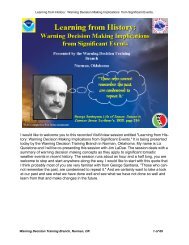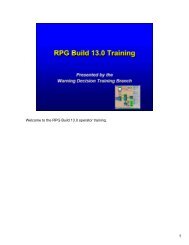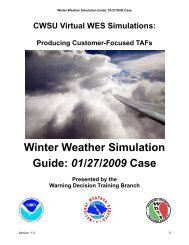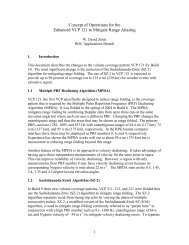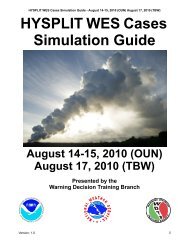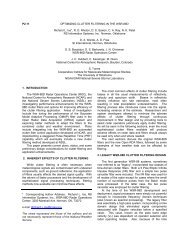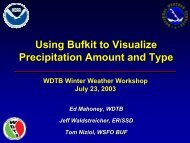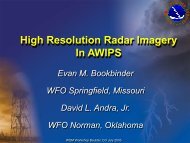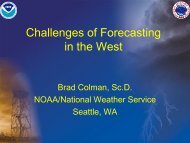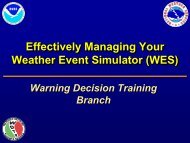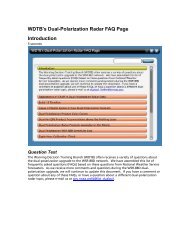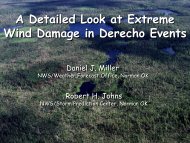PDF, 7.4 MB
PDF, 7.4 MB
PDF, 7.4 MB
- No tags were found...
You also want an ePaper? Increase the reach of your titles
YUMPU automatically turns print PDFs into web optimized ePapers that Google loves.
Towards Improvements in QPEfor Flash Flood Applications inNWSJ.J. GourleyNational Severe Storms LaboratoryCoop. Inst. For Mesoscale Metr. StudiesNorman, OK3/26/2012 WDTB Severe Weather/Flash Flood WDM
Outline• Challenges in radar precipitation estimation• New techniques in automated QPE• QPE SUMS technique description• QPE SUMS case results• Algorithm evaluation efforts• Latest improvements and diagnostic products
Quantitative PrecipitationEstimation (QPE) by Radar• Reflectivity to Rainfall Conversion Problems Drop size distributions Mass flux• Sampling Problems Anomalous propagation Ground clutter Beam overshooting Mixed-phase sampling Hail contamination Bright band contamination
Z-R Problems• Precipitating clouds have different drop sizedistributions (DSD) requiring different Z-Requations.Z=1mm 6 m -3 Z=.25mm 6 m -3Z = 1∆V Σ 6iD iSame rainfall amount, but different reflectivities!
“Mass Flux” Impactsfrom Dotzek and Fehr (submitted to J. Appl. Metr.)• KAMM (Karlsruhe Mesoscale Model) shows theimpact of vertical velocities on rainfall ratesw=0 w=“on”
Anomalous Propagation• Results from nonstandard beam propagation
Ground Clutter• Results from radar returns from nearby trees,mountains, buildings, towers, etc.
Hail Contamination• Reflectivityfactor sensitiveto hydrometeordiameters andwater-coating
Beam Overshooting/Mixed-Phase Sampling• Creates a rangedependenceinprecipitationestimates
Bright Band Contamination• Region of high reflectivity caused by meltinghydrometeors Steady state Horizontallyhomogeneous
And the Result is…• Overestimations can be as large as an order ofmagnitudeSpringfieldPhoenix
New QPE Strategies1. Merging radar products with gauges - NWS OHD2. Satellite-based QPE (Hsu et al. 1996; Vicente et al.1998)3. Correction of accumulations by using a VerticalProfile of Reflectivity (VPR; Joss and Waldvogel1970)4. Use of Dual-polarization variables (Ryzhkov et al.1997)5. Multisensor QPE (Gourley et al. 2002)
5. Multisensor QPEA little history first….• Gourley et al. (2002) found radar-only QPEs wereof little use in AZ during cool season• Inclusion of satellite data = better QPE amounts• NSSL redesigns precipitation algorithm fromscratch Use of CRAFT network permits real-time experience C++/Object Oriented Design• Quantitative Precipitation Estimation andSegregation Using Multiple Sensors is born
RadarSatelliteIRSurfaceObsUpperAir ObsLightningINGESTPOLARDATAAndRunalgsPRECIPESTIMATIONMOSAICModel
Modules in Polar Coordinates• Radar data ingest and QC• Determination of precipitation type/characterConvective/Stratiform segregationBright band identification (BBID)• Identification of regions that are sampledadequately by radar based on:Precipitation type/characterRadar beam heightsEnvironmental data (RUC2 analyses)Polar
Radar Data Ingest• WSR-88D (DoD and NWS) and TDWR (FAA)• Level II format (all tilts, full resolution)• Via LDM compression/networking softwarePolar Read in real-time from CRAFT network 56k modem sufficient• C++/OO design accommodates ingest of data inany format
AP and GC removal(Phoenix, AZ)beforeafter+KIWA+KIWAPolar Hybrid Reflectivity Level Vertical Continuity Nonzero Velocity
Precipitation Typing• Identifies and segregates precipitation type.PrecipitationConvective Stratiform Warm CloudBright band/RUC 0CBeam heightsGoodBadPolar
Conv/Strat Segregation• dBZ > 50 in any bin or,• dBZ > 30 at temperatures < -10 C or,• 1 lightning flashPolarComposite ReflectivityPrecip Flags
What else is lightning used for?• Accumulations of flash density and % positive 5-m, 1-h, 24-h
Bright Band Identification(BBID)• 3-D Reflectivity Field• ID Layer of Higher Reflectivity• Vertical Reflectivity Gradient• Spatial/Temporal SmoothingPolar
Comparisons of BBID withRUC2 0°C HeightsKLTXKRAXKAKQKCAE
Comparisons of BBID withVertically-Pointing Radar DataPolar
Identification of Contaminationin Precipitation Rate Maps
Radar Sampling ofPrecipitation Type• Identifies and segregates precipitation type.PrecipitationConvective Stratiform Warm CloudBright band/RUC 0CBeam heightsGoodBadPolar
Identification of Good RadarRainfall MeasurementsStrat Rain (good)Convective (good)Bright Band (bad)Frozen (bad)QuickTime and aNone decompressorare needed to see this picture.?Polar
Generate Polar Products(Text, Nids, Binary, NetCDF)• Base Reflectivity (raw and qc’d)• Base Velocity• Spectrum Width• Hybrid Reflectivity• Composite Reflectivity• Precip Rate• Precip FlagsPolar
RadarSatelliteIRSurfaceObsUpperAir ObsLightningINGESTPOLARDATAAndRunalgsPRECIPESTIMATIONMOSAICModel
CartesianModules in CartesianCoordinates• Mosaicking of polar rates and flags• Assignment of precipitation phase based ongridded RUC 0C height vs. surface elevation• Ingest and remapping of satellite IR data• Regression between good stratiform rates andcollocated satellite cloud top temperatures• Application of multisensor precipitation rates• Product generation
Adaptive Mosaicking• Maximizes amount of low-level radar coverageAll Radars No KIWA/KICX No KFSX/KICXCartesian
Determination of PrecipitationPhase at Surface• Compare RUC0°C heights withterrain heightsRUC 0C Isotherm• Create 2-D surface showingprecipitation phaseRain/Snow LineCartesian
Satellite/Radar RegressionRadar RainrateQuickTime and aNone decompressorare needed to see this picture.?Satellite CTTQuickTime and aNone decompressorare needed to see this picture.Regression Equation
Generating Multisensor FieldRegression EquationQuickTime and aNone decompressorare needed to see this picture.Satellite CTTQuickTime and aNone decompressorare needed to see this picture.QPE SUMS RainfallRate
Gauge Calibration• Ingest all available rain gauges in domain(ALERT, USGS, Mesonet, LARC, Co-op, Prisms)• Perform QC on gauges based on Shafer et al.(2000)• Software capable of performing mean field biasand local bias adjustment (Seo et al. 2002)• However, gauge data are withheld from current,operational version: permits evaluation
QPE SUMS Product Generation• 3 different flavors of precipitation algorithm Radar-only Satellite-only Multisensor• Rates are accumulated over time 5, 15, 30-min accums 1, 1.5, 3, 6, 24, 72-hour accums User-selectable time period• Product resolution 45 products every 5 mins 1x1 km grid covering roughly 400 x 600 km region
WISH DeploymentsArizona/SRP Oklahoma/FAAN&S Carolina/Sea GrantAlabama/NASAOperational DeploymentsFuture Deployments
Evaluation Efforts• Case study approach (NC and AZ Domain)• Comparison with gauges (OK Domain)• Future Work: Uncertainty estimation usinggeneralized likelihood measures with a hydrologicmodel
• One migrant worker was killedCentennial Wash Flash Flood• 4-6” of rain fell in the headwaters of CentennialWash, near Wenden AZ on Oct. 22, 2000• Resulting runoff reached depths of 12 feet anddischarge exceeded 20,000 cfs• 125 mobile homes were inundated and transporteddownstream• Property damage exceeded $6M
CentennialWashPhoenix RadarYuma Radar
AutoEstimator - Storm TotalPrecipitationCentennialWash
QPESUMS Radar Only -Storm Total PrecipitationCentennialWashBright bandcontamination
QPESUMS Multisensor -Storm Total PrecipitationCentennialWash
Gauge Comparison:Storm Total StatisticsALERTGauges (9)QPESUMSMultisensorQPESUMSRadarAutoEstimatorSUM 20.96 24.83 29.61 8.6BIAS 1.13 1.32 0.41RMSE 1.31 1.94 1.49CORRCOEFF0.76 0.75 0.67
Gauge Comparison:Hourly StatisticsALERTGauges (9)QPESUMSMultisensorQPESUMSRadarAutoEstimatorBIAS 1.24 1.50 0.67RMSE 0.28 0.32 0.27CORRCOEFF0.66 0.67 -0.02
6-Month Statistics in OKDomain: BiasMultisensorRadar-Only
Correlation CoefficientMultisensorRadar-Only
MultisensorRadar-OnlyRMS Error
Conclusions• QPE SUMS is equipped with internal modulesthat have many diverse uses• Multisensor algorithm performs similarly to radaronlyfor convective events• Differences arise where radar-only estimates ofprecipitation suffer: Complex terrain Stratiform precipitation Orographic precipitation• Multisensor approach offers hope in these “radarhostile” regimes
Latest Improvements andDiagnostic Products• Radar calibration differences plotted on web page• New occultation files and hybrid scans for allradars in US• Overlay of gauge amounts on products• Additional AP removal using satellite/RUC data
Effects of Radar CalibrationDifferencesMosaics showboundaries inQPE amountsfrom adjacentradars500 ft. rule alsocreates artifactaround KTLXradar
Radar Calibration Differences
NSSL Occultation Files andHybrid Scans• Uses 30-m DEM from EROS• Models power density weighting of beam• Adaptive - allows investigation of new VCPs• Derivation of hybrid scans removes the “500 ft.rule” Cleans up artifacts due to prior use of higher tilts nearradar Permits integration of dual-pol data when available
KIWA Hybrid ScanAfterBefore
AP Removal usingSatellite/RUC
Questions???gourley@ou.edu



